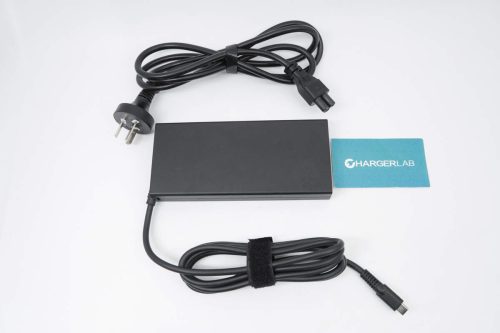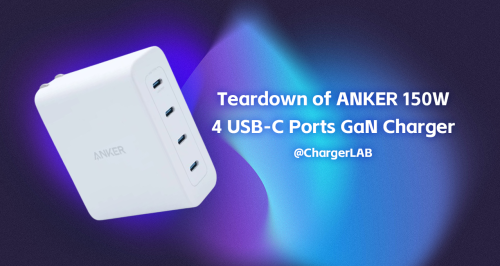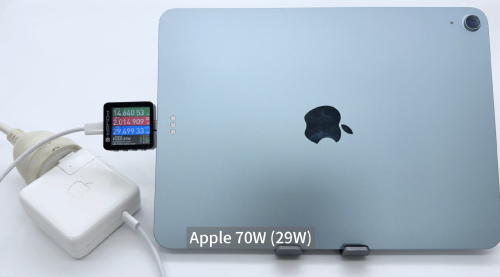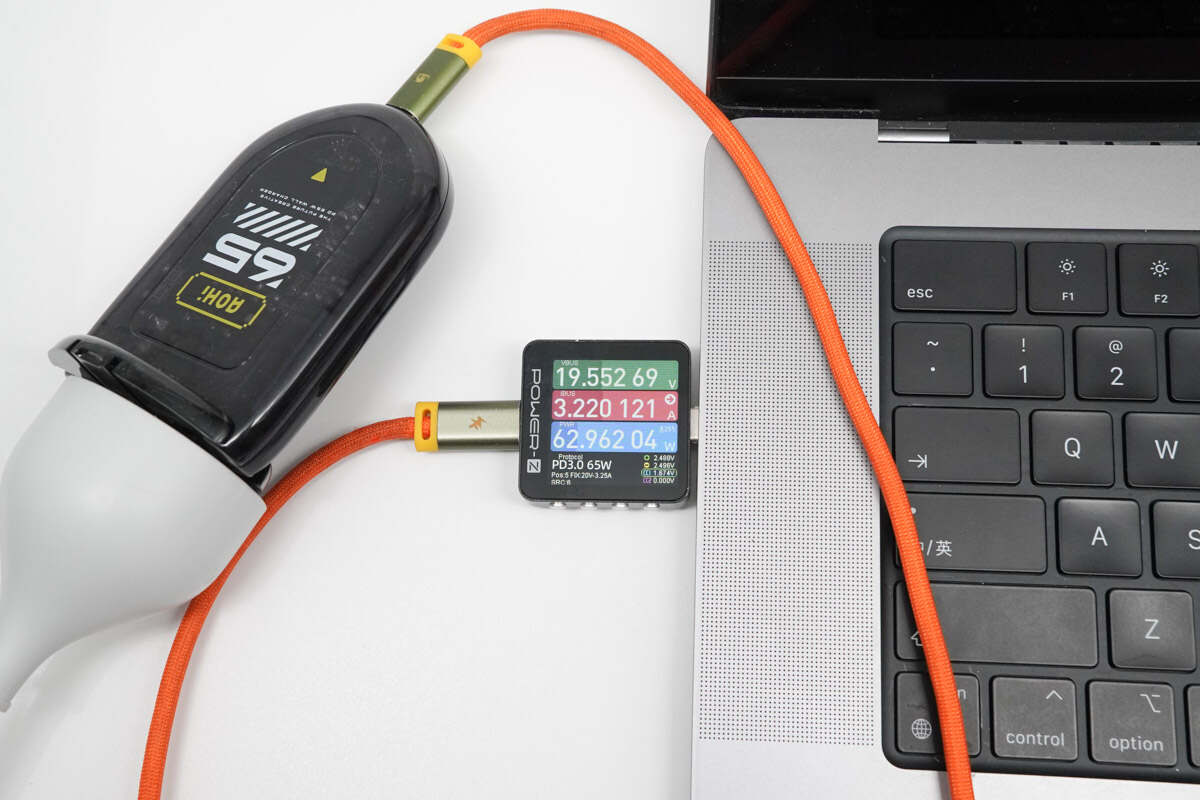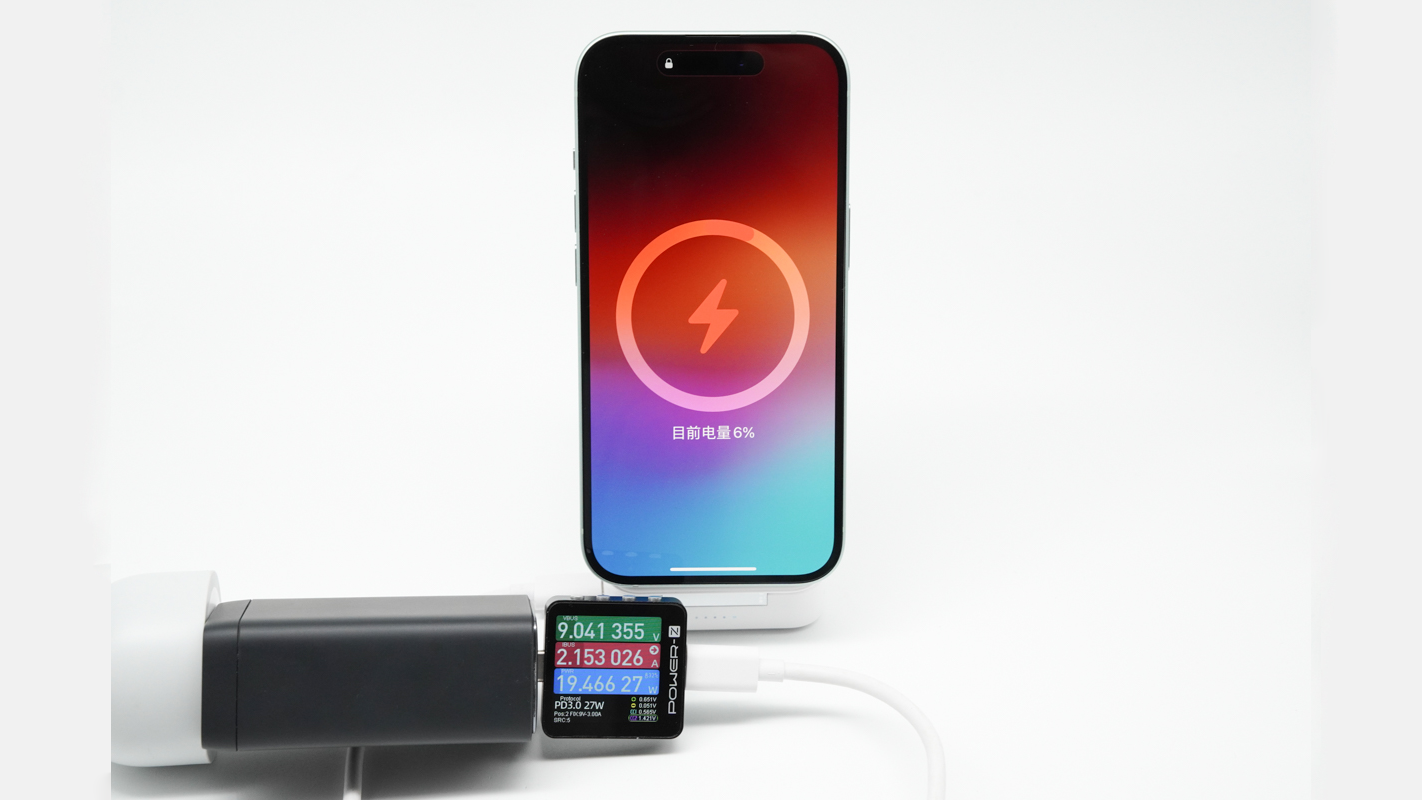Introduction
As hardware performance continues to iterate and upgrade, the performance of laptops is becoming more and more powerful, and the demand for stable power supply is also increasing. Stable high-load operation or processing of complex tasks cannot be separated from a stable power supply. As a well-known brand in the power supply field, Delta has launched the world's first power adapter that supports PD3.1 240W with its deep technical accumulation and innovative spirit.
ChargerLAB got our hands on this product as soon as possible. It supports multiple voltage outputs such as 28, 36, and 48V, and can meet the needs of a variety of high-power devices, especially the upcoming laptops equipped with RTX 50 series graphics cards. Next, we will evaluate this Delta PD3.1 240W power adapter from multiple dimensions.
Product Appearance
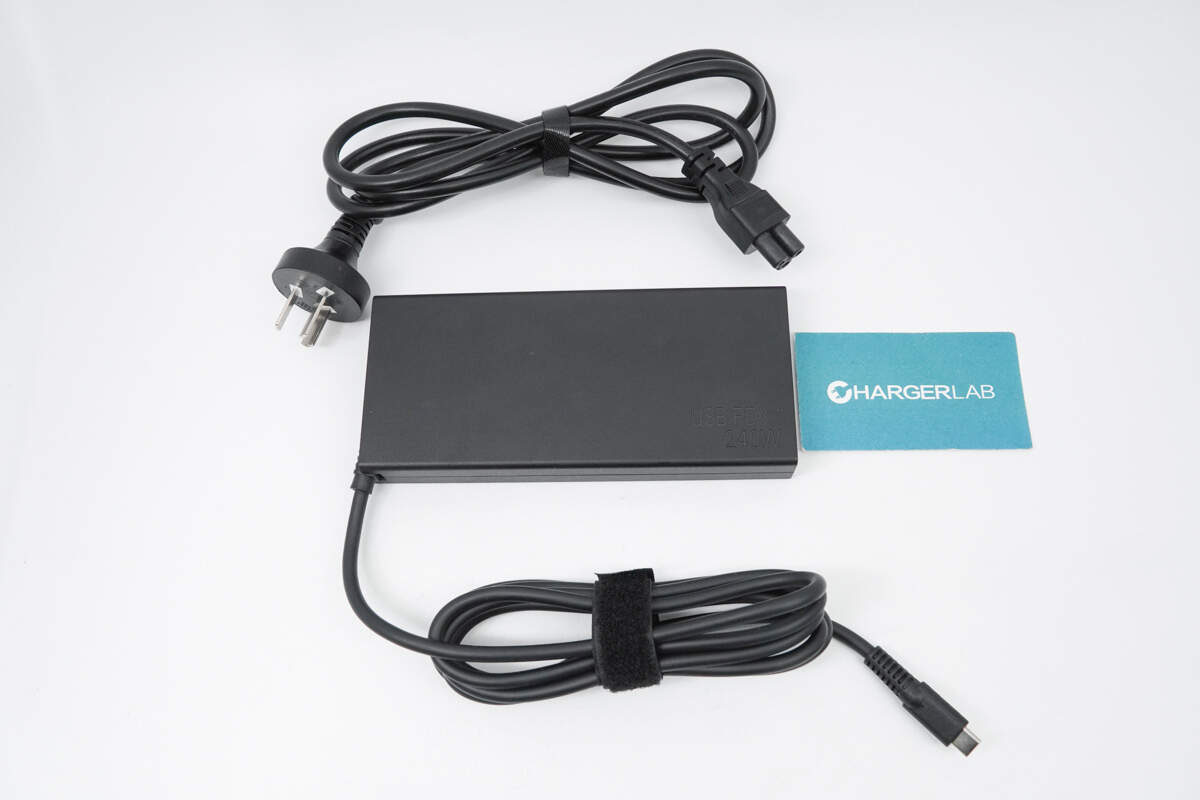
Delta PD3.1 240W power adapter has a flat appearance and is equipped with an integrated USB-C cable. The outer shell is made of fire-resistant PC with a frosted surface.
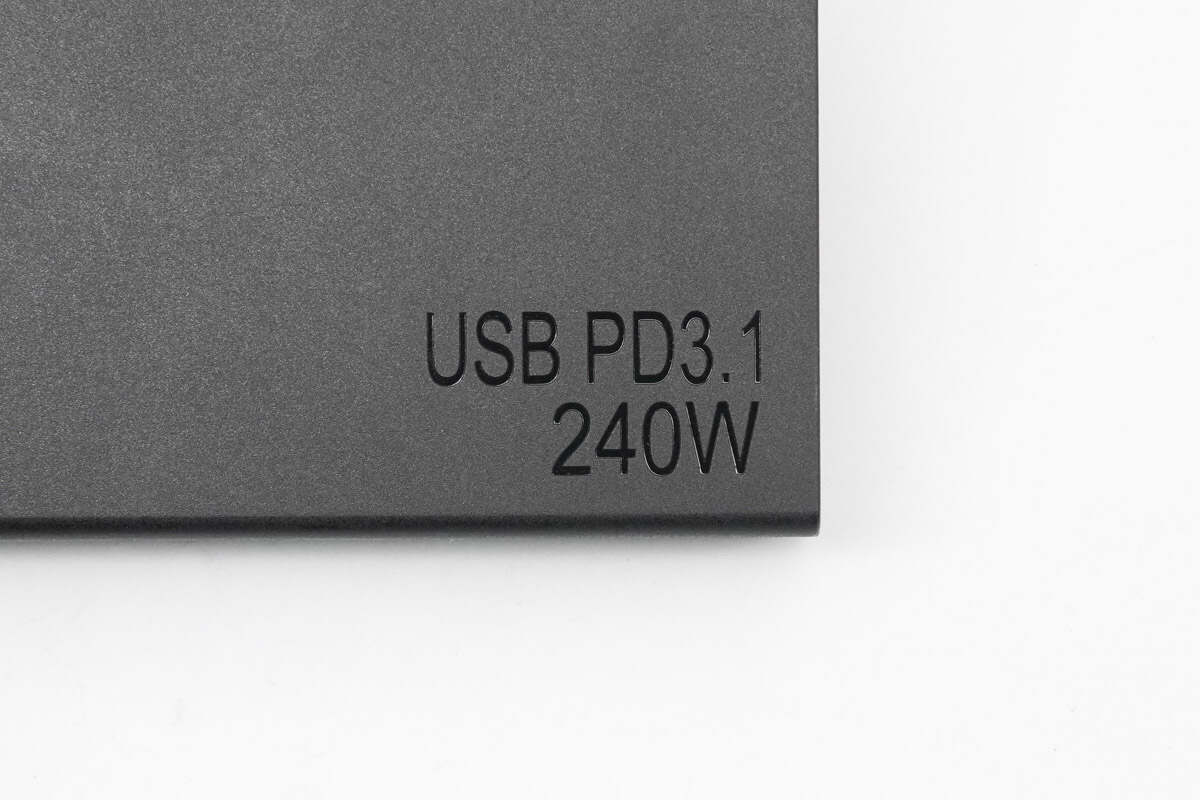
The words USB PD3.1 and 240W are embossed on the lower right corner of the front.
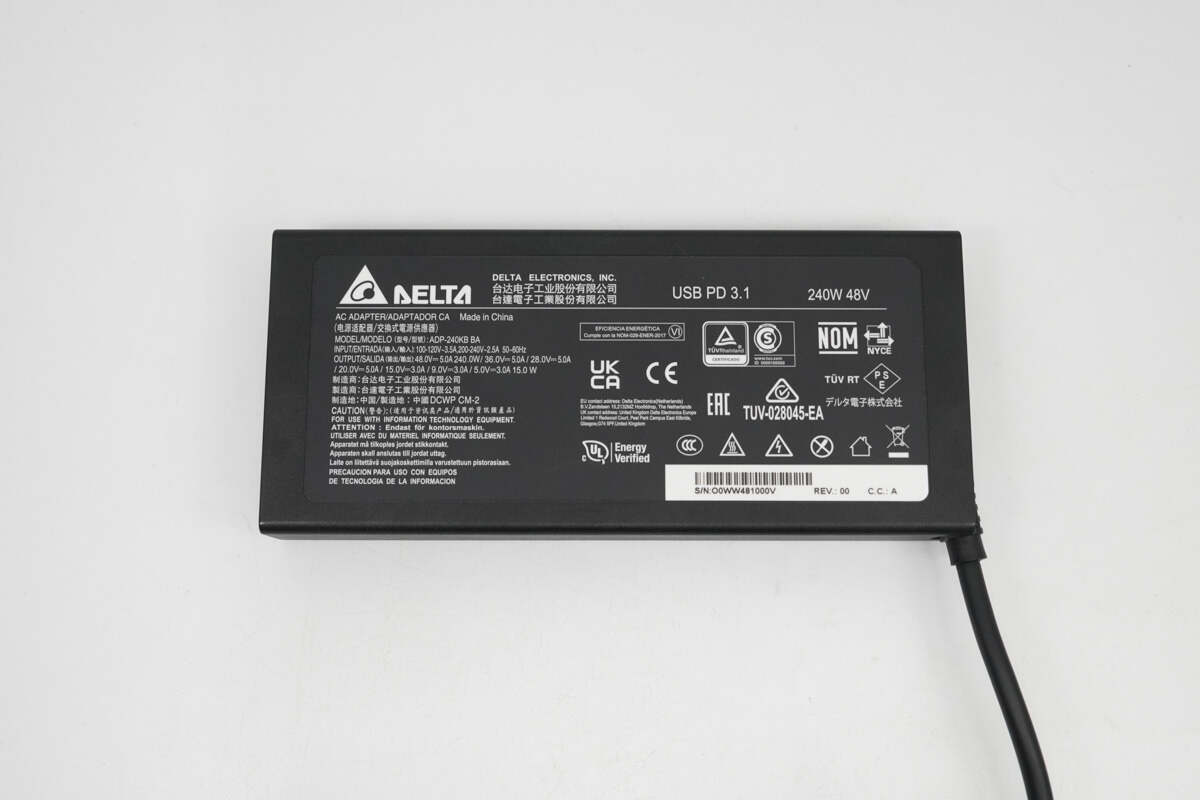
There is specs info on the back. Model is ADP-240KB BA. It can support input of 100-120V~ 3.5A or 200-240V~ 2.5A 50/60Hz. It can support output of 48V5A 240W, 36V5A, 28V5A, 20V5A, 15V3A, 9V3A, and 5V3A 15W.
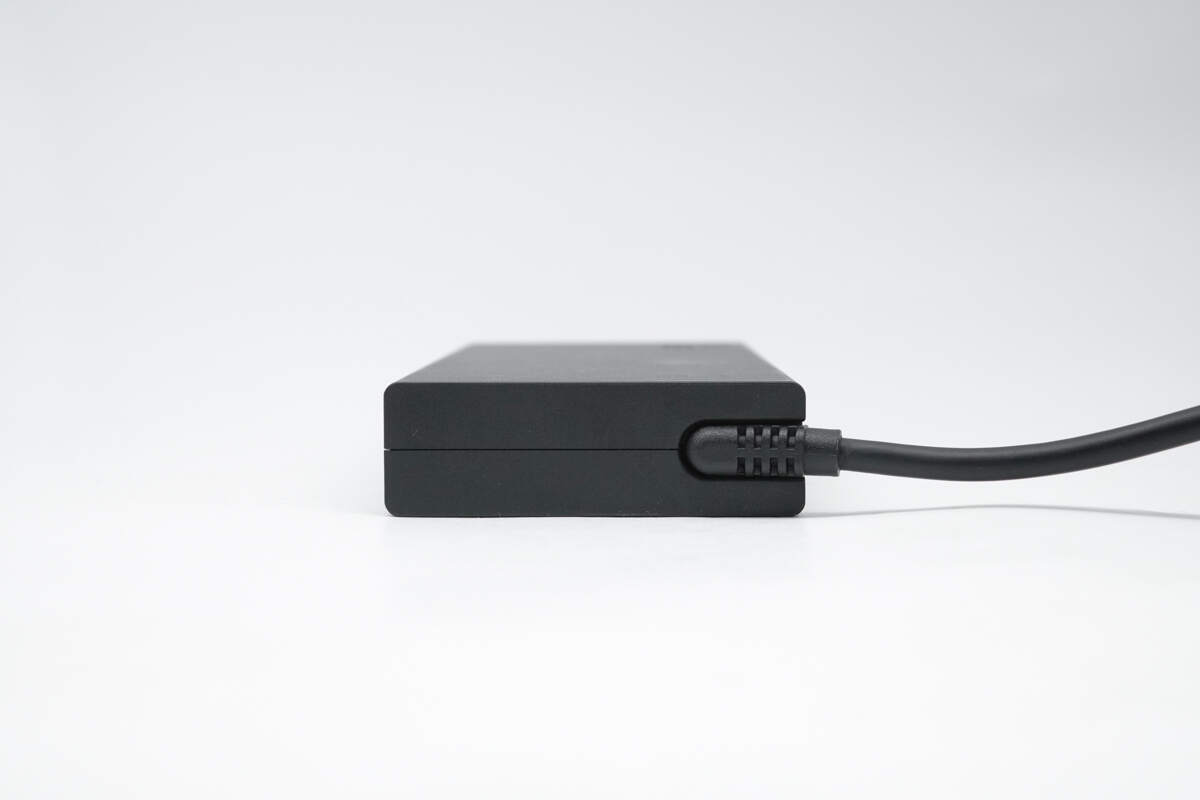
There is a locking slot on it to protect the USB-C output cable.

The USB-C connector is extended and thickened.
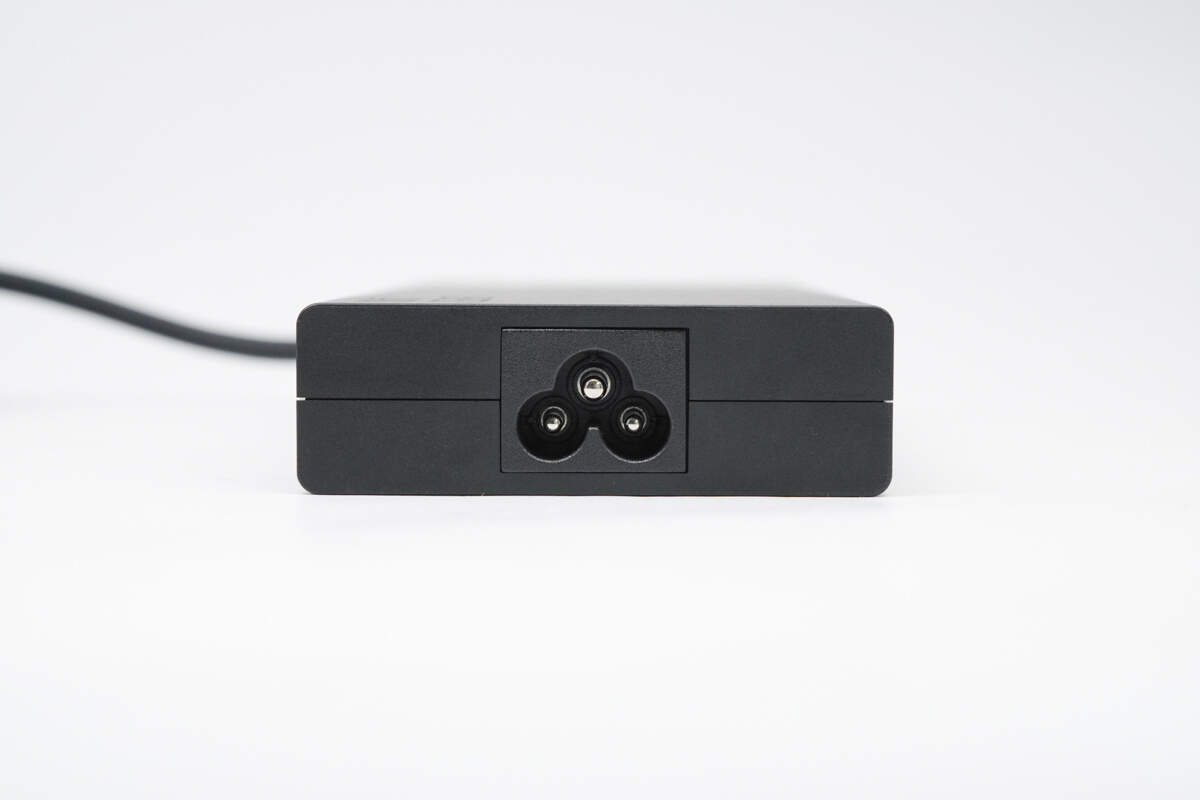
The power input socket uses a 3-prong design, and the pins are made of copper-nickel-plated material, which has stronger conductivity and is wear-resistant and scratch-resistant.
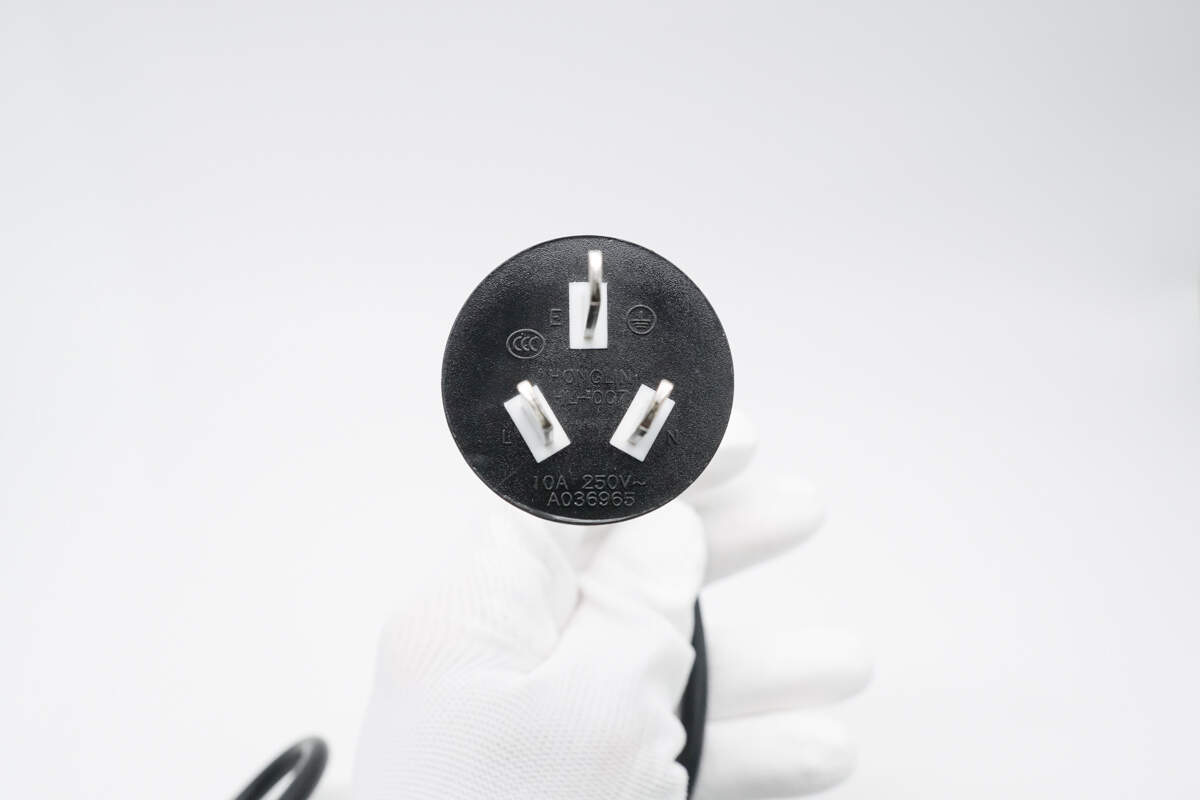
The input cable adopts a 3-prong design and is printed with 10A 250V~.

The length of the output cable is about 180 cm (5 feet 10.9 inches).
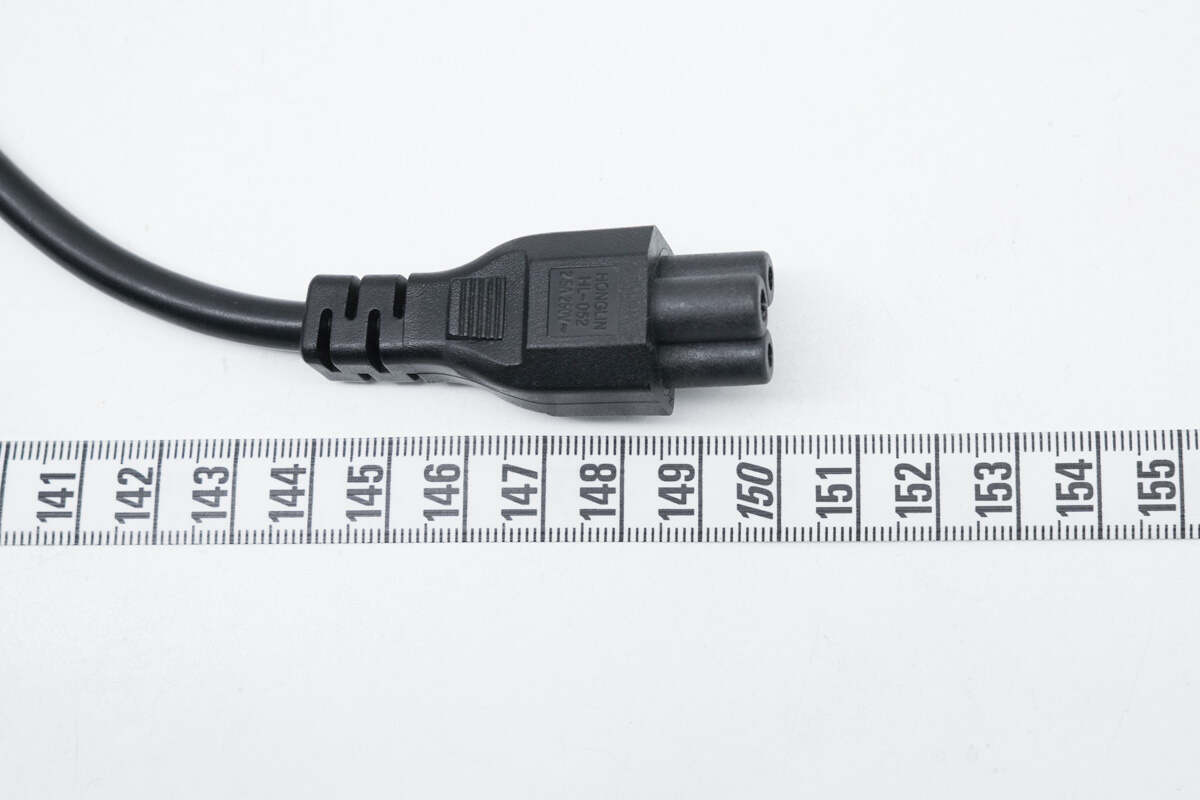
The length of the power cord is about 150 cm (4 feet 11 inches).
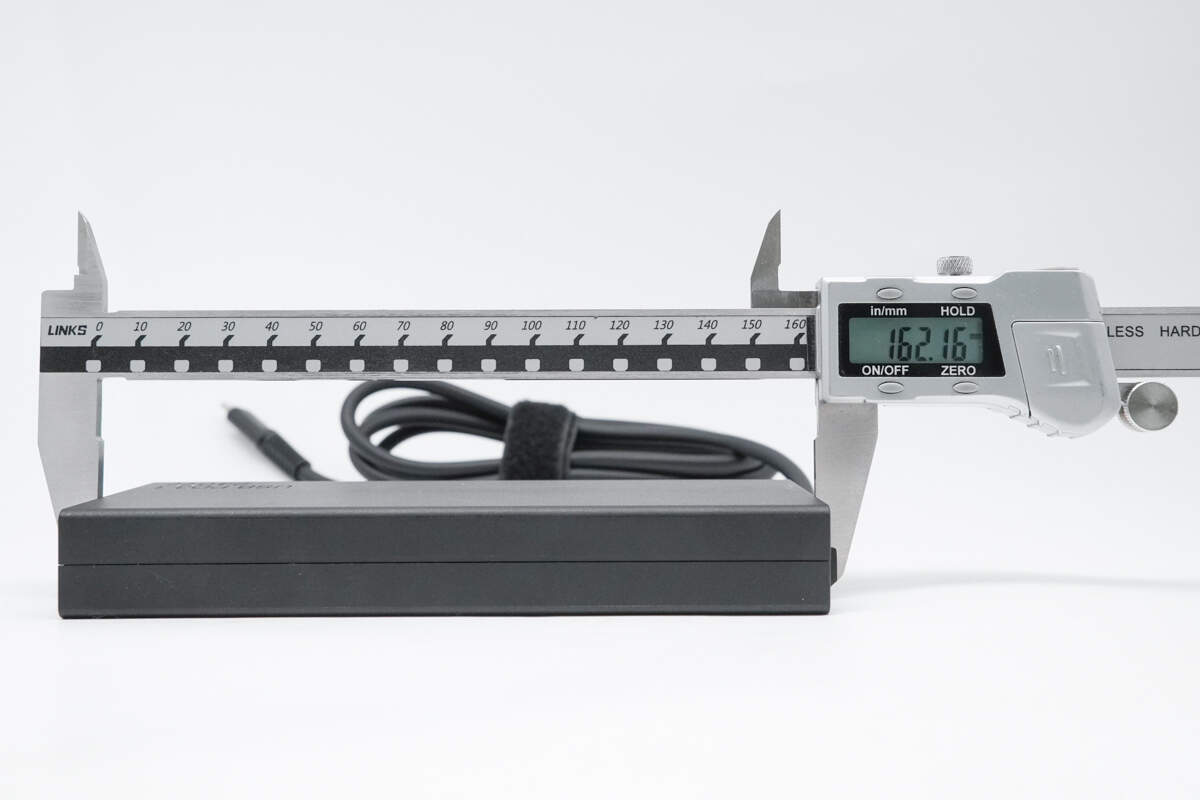
The length of the adapter is about 162.16 mm (6.38 inches).
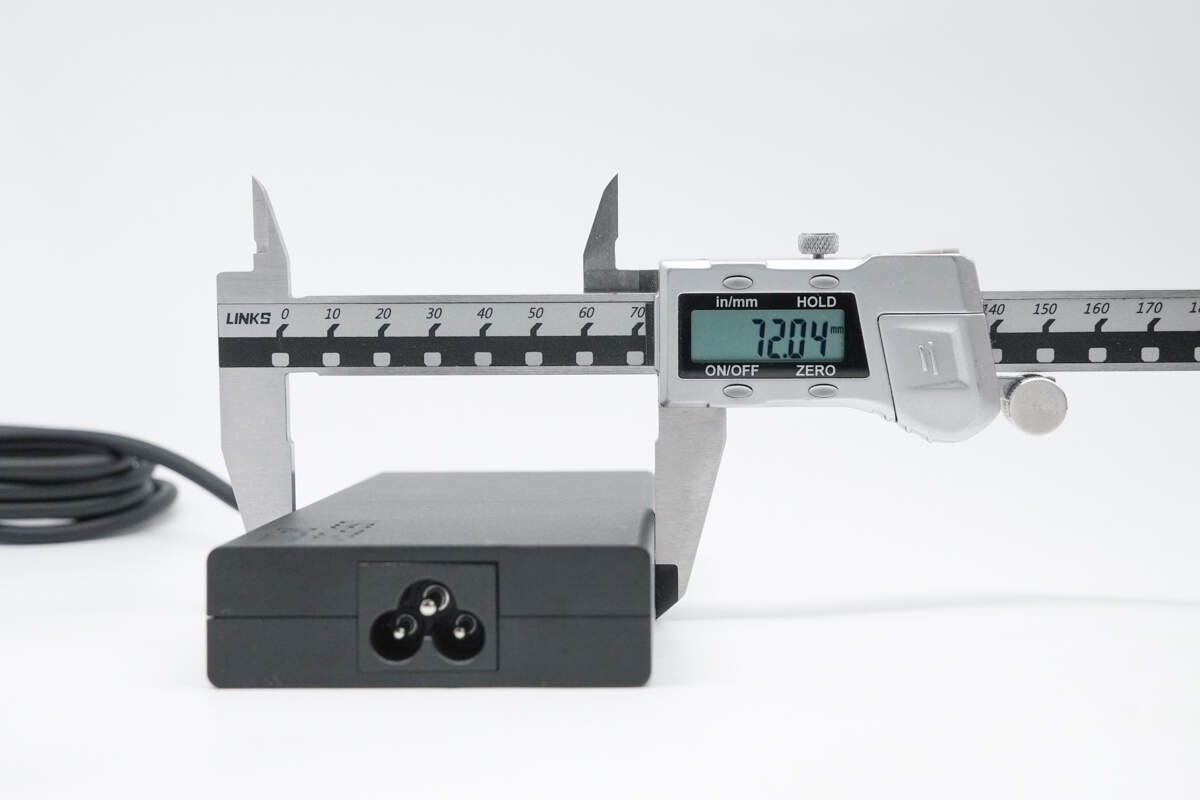
The width is about 72.04 mm (2.84 inches).
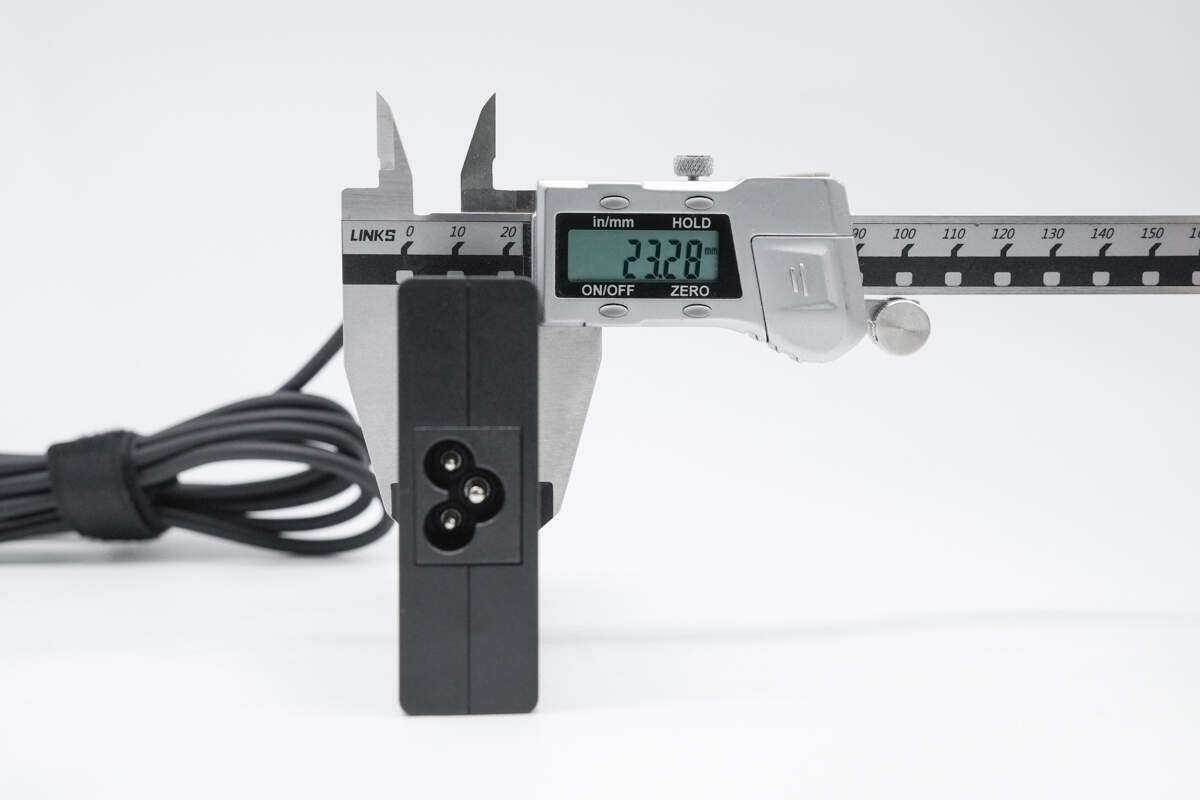
The thickness is about 23.28 mm (0.92 inches).

And the weight is about 710.5 g (25.062 oz).
Protocol Test

ChargerLAB POWER-Z KM003C shows it supports PD3.1, PPS, QC5, and DCP charging protocols.
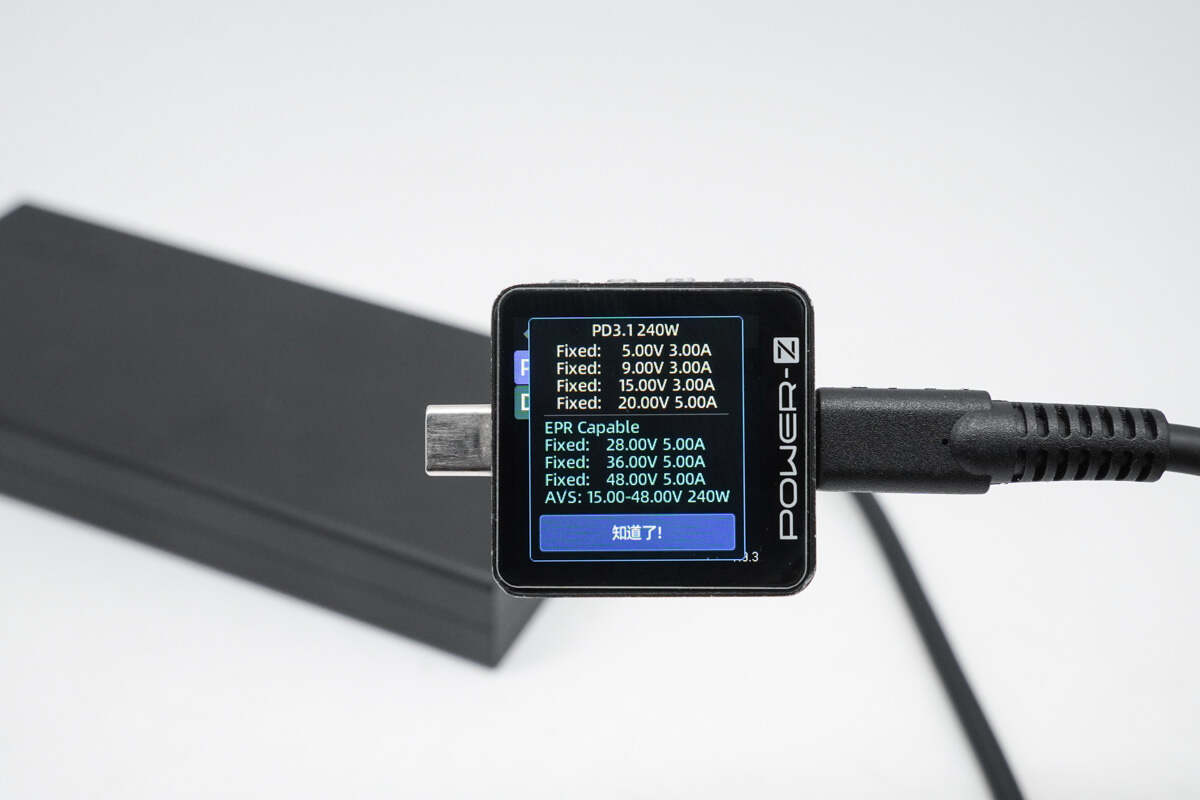
And it has seven fixed PDOs of 5V3A, 9V3A, 15V3A, 20V5A, 28V5A, 36V5A, and 48V5A. It has a set of AVS, which is 15-48V 240W.
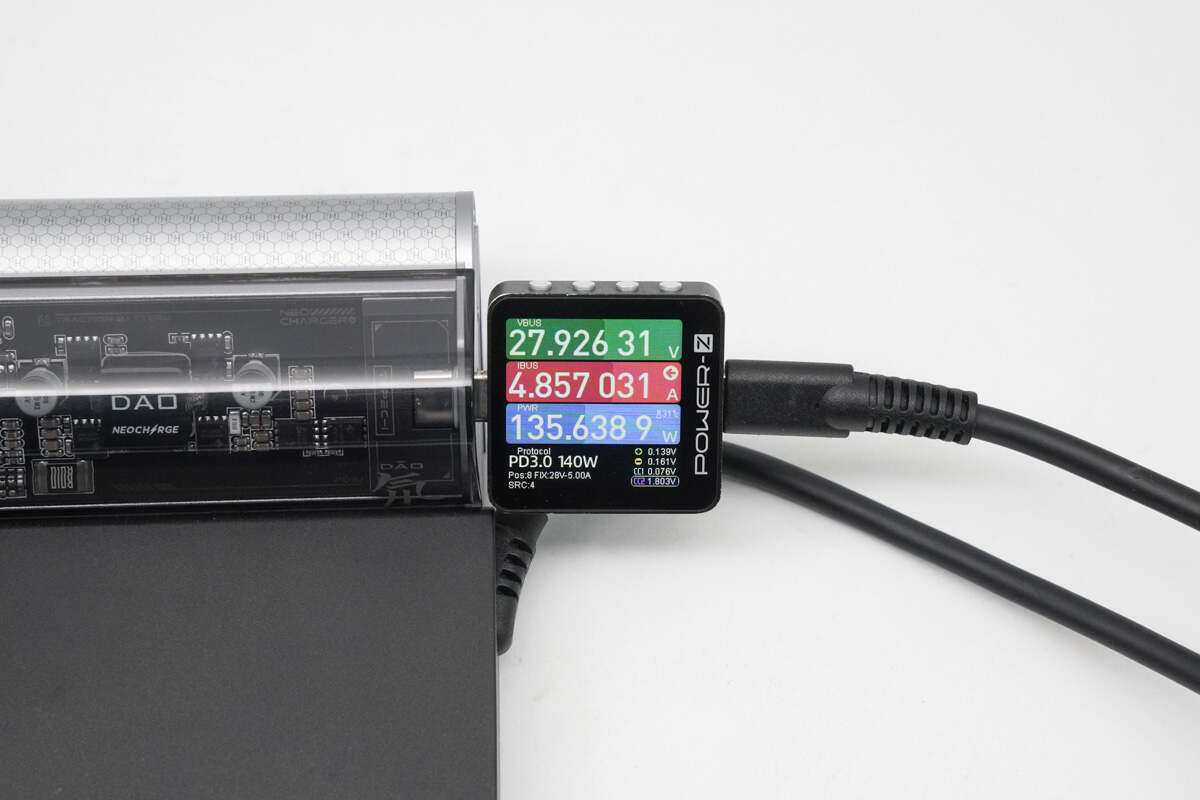
Use Delta PD3.1 240W power adapter to charge REDMAGIC DAO 20000mAh Power Bank which supports PD3.1 140W input, and the charging power can reach about 135W.
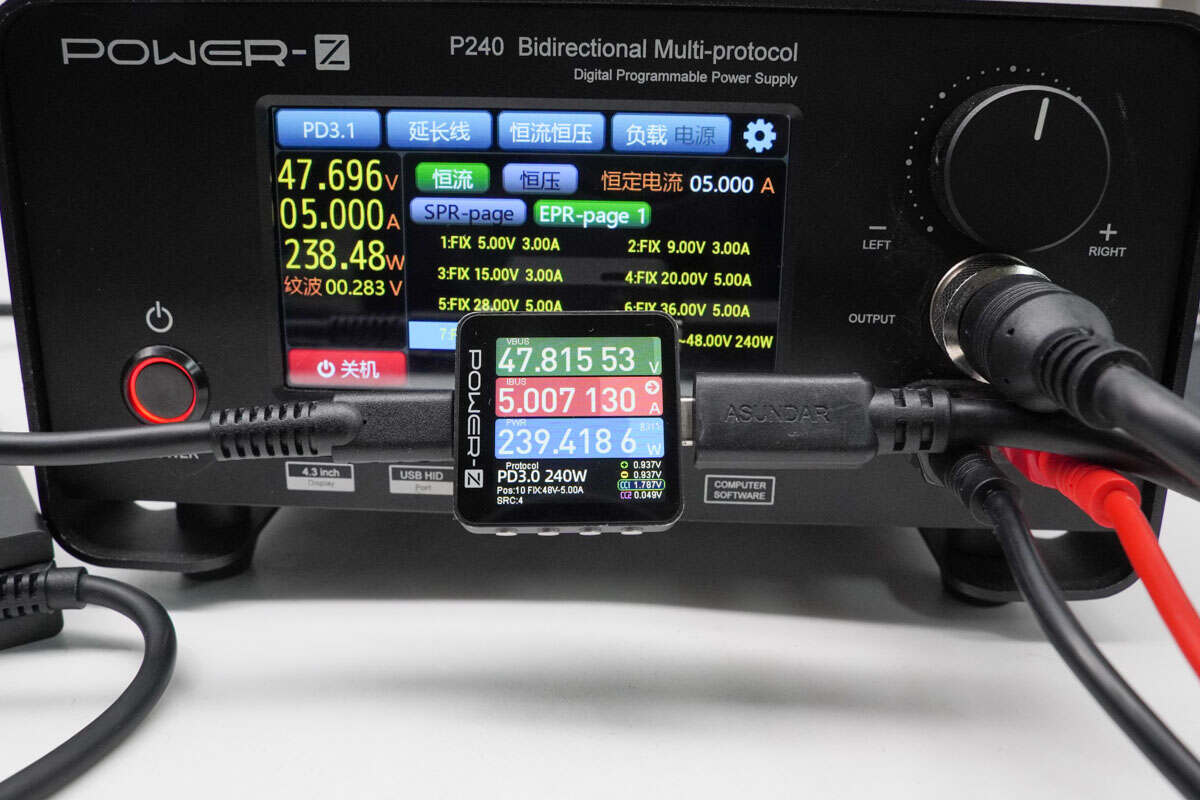
Under the load of the POWER-Z P240 tester, it can output a stable power of around 240W.
Charging Test
Now, let's take a look at its charging test.
Compatibility Test
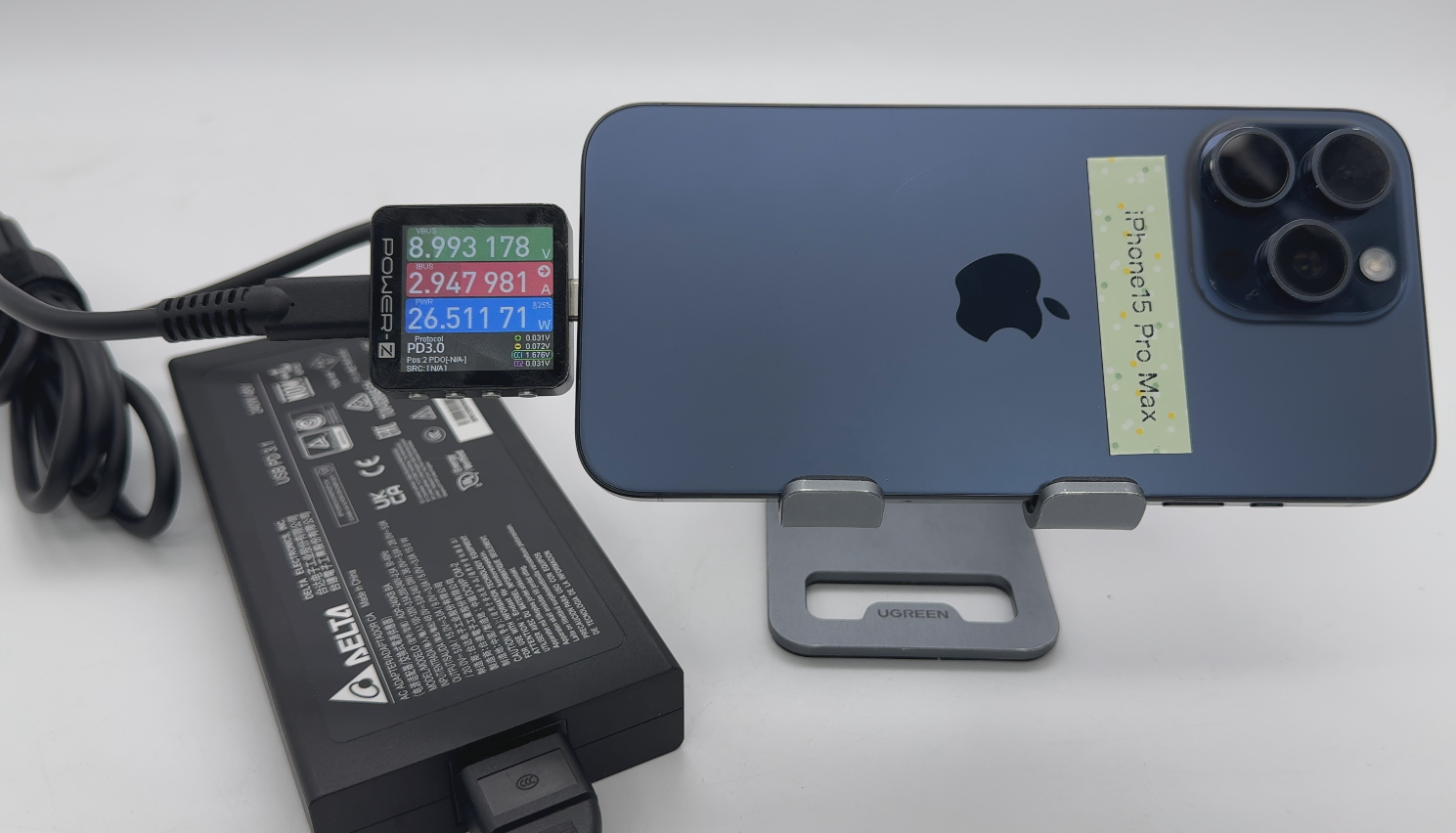
Use it to charge the iPhone 15 Pro Max, ChargerLAB POWER-Z KM003C shows the power is about 8.99V 2.95A 26.51W.
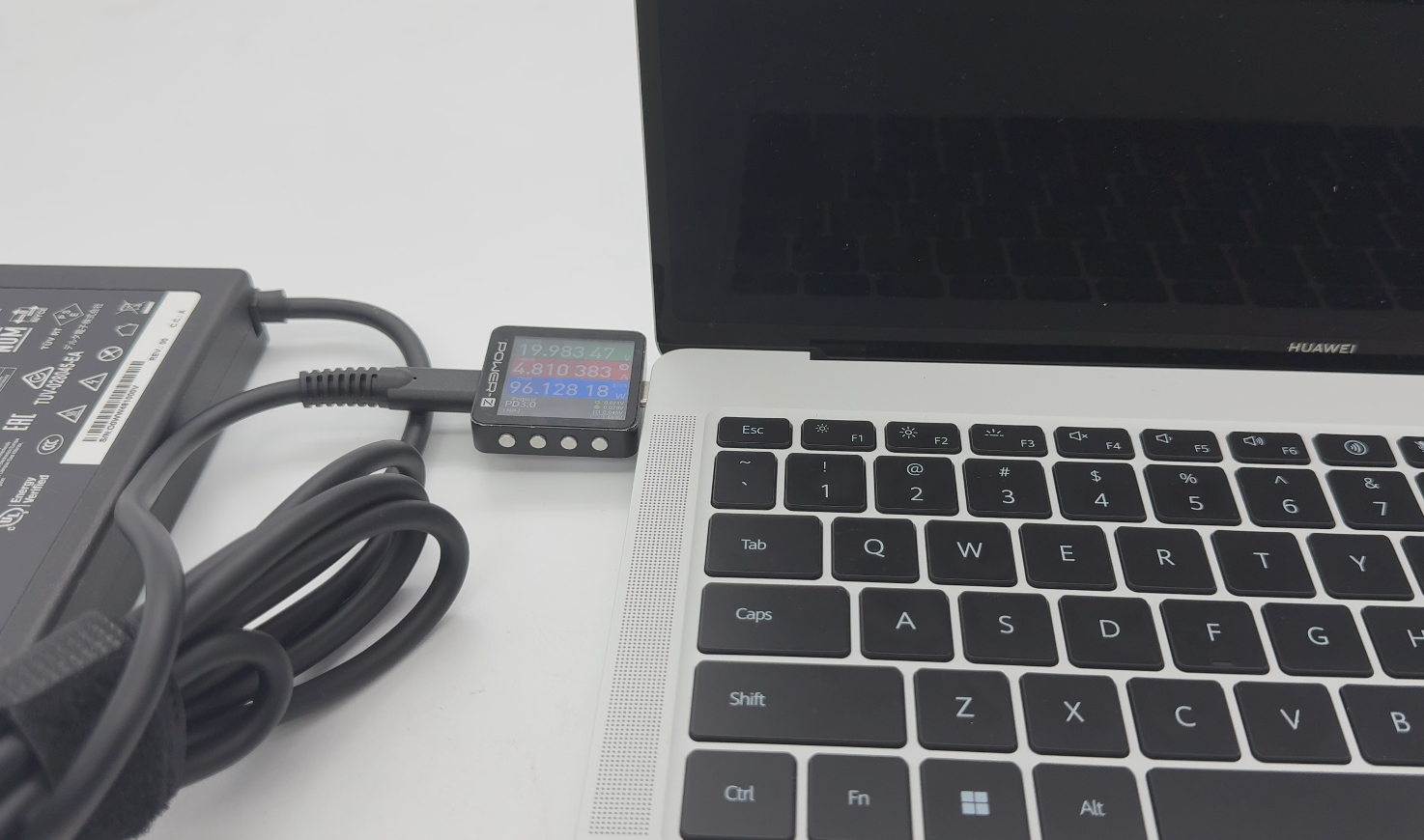
Use it to charge the Huawei MateBook X Pro, ChargerLAB POWER-Z KM003C shows the power is about 19.98V 4.81A 96.13W.

As you can see, there is no compatibility issue. The input voltage of the phones can all reach 9V, and the power ranges from 9 to 26W. And game consoles, tablets, and laptops can reach about 15V or 20V. For devices that support PD3.1 fast charging, the voltage can reach 28V.

We have compiled the test results into a bar chart. The highest charging power is 137W of the MacBook Pro M4 Pro. It is more suitable for use with high-power devices, but it can also charge phones in emergencies, but the charging power is relatively low.
Full Charging Test
Currently, the maximum input power of the USB-C port of devices on the market is around 140W, which cannot fully utilize the power of Delta PD3.1 240W power adapter, but the actual measured data can also be used as a reference.
Next, we'll use it to fully charge the 16-inch MacBook Pro M4 Pro. The charger and the laptop will be put into a 25°C (77℉) thermotank throughout the test. Here is the charging curve made by the PC software of KM003C.
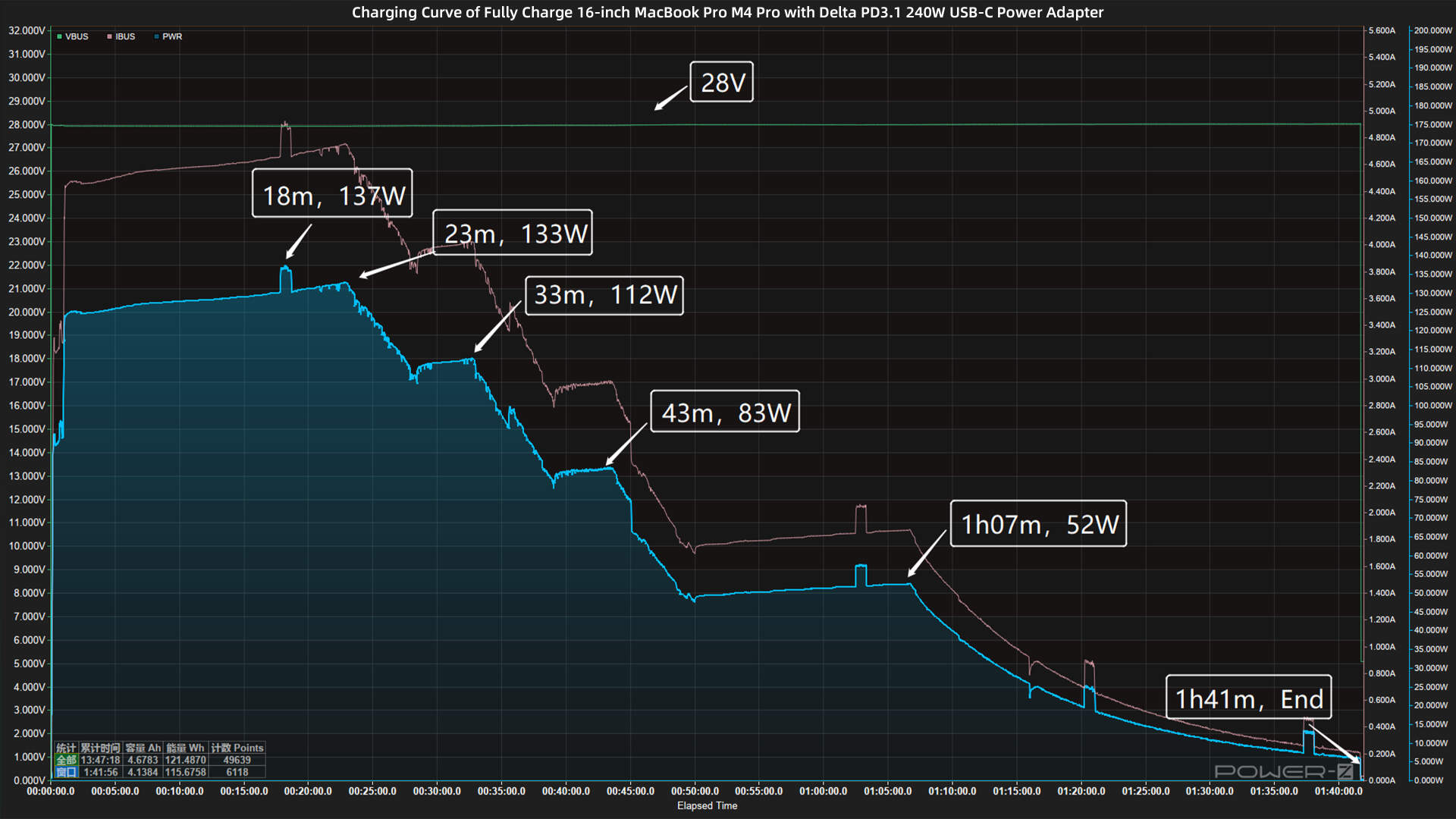
The voltage is always around 28V. The charging curve can be divided into six parts. In the first part, the peak power stayed at 137W for the first 18 minutes. Then, the power gradually drops to 133W, 112W, 83W and 52W in turn. The final part begins at 1 hour and 7 minutes, and the power slowly drops to almost zero. It takes 1 hour and 41 minutes to be fully charged.
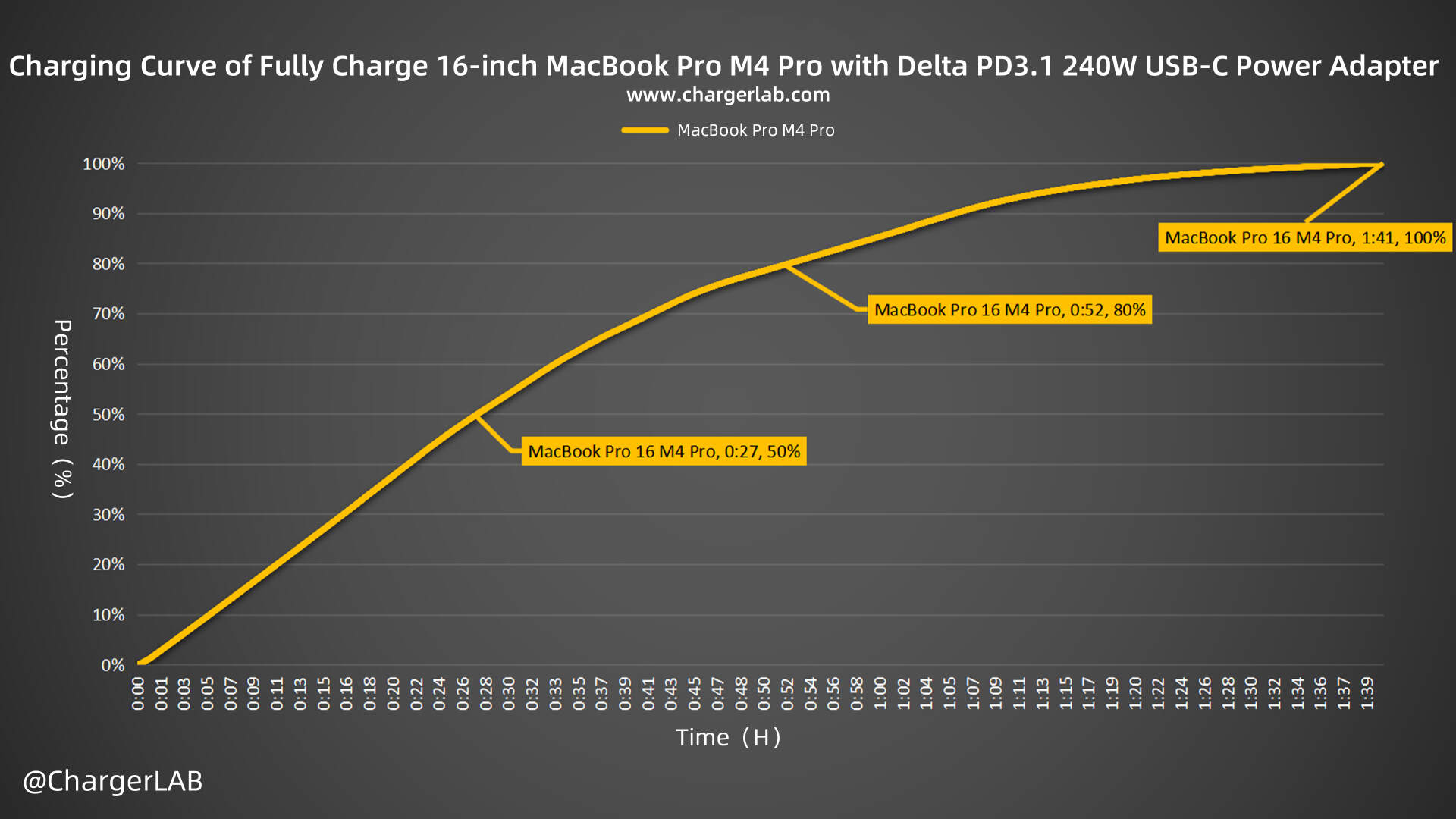
We plot it into another curve to see how fast it can be. It can charge the 16-inch MacBook Pro M4 Pro to 50% in 27 minutes and 80% in 52 minutes, and it reaches 100% in 1 hour and 41 minutes. The charging time is almost the same as the 140W charging set that comes with the laptop.
Standby Power Test
Next, we will test its standby power consumption.

The power consumption at 220V 50Hz is 0.03W, and 0.008W at 110V 60Hz, which is about 0.26 and 0.07KW·h in one year, respectively. So, you do not need to worry about the waste of the electricity.
Conversion Efficiency Test
Then, we are going to the conversion efficiency test.

The conversion efficiency varies from 88.89% to 95.28% at 220V 50Hz, and the conversion efficiency varies from 87.98% to 93.79% at 110V 60Hz. The charger achieves a conversion efficiency of up to 95.28% under the two voltages.
Overall, the conversion efficiency of Delta PD3.1 240W power adapter under two voltages performs well among similar devices.
Ripple Test
Power adapters rely on switch-mode power supplies, which means that the output from the transformer's secondary winding is not direct current and must be rectified and filtered by capacitors before being outputted. As a result, ripples can exist in the output signal. To evaluate the quality of the adapter's output, ChargerLAB employs an oscilloscope to test the ripple value of the converter's output and compare it with industry standards. In general, the lower the ripple, the higher the output quality.

Firstly, let's check out its ripple without load. When the output is 15V0A, the lowest ripple is around 122 mVp-p. When the output is 20V 0A, the highest ripples are around 222 mVp-p.
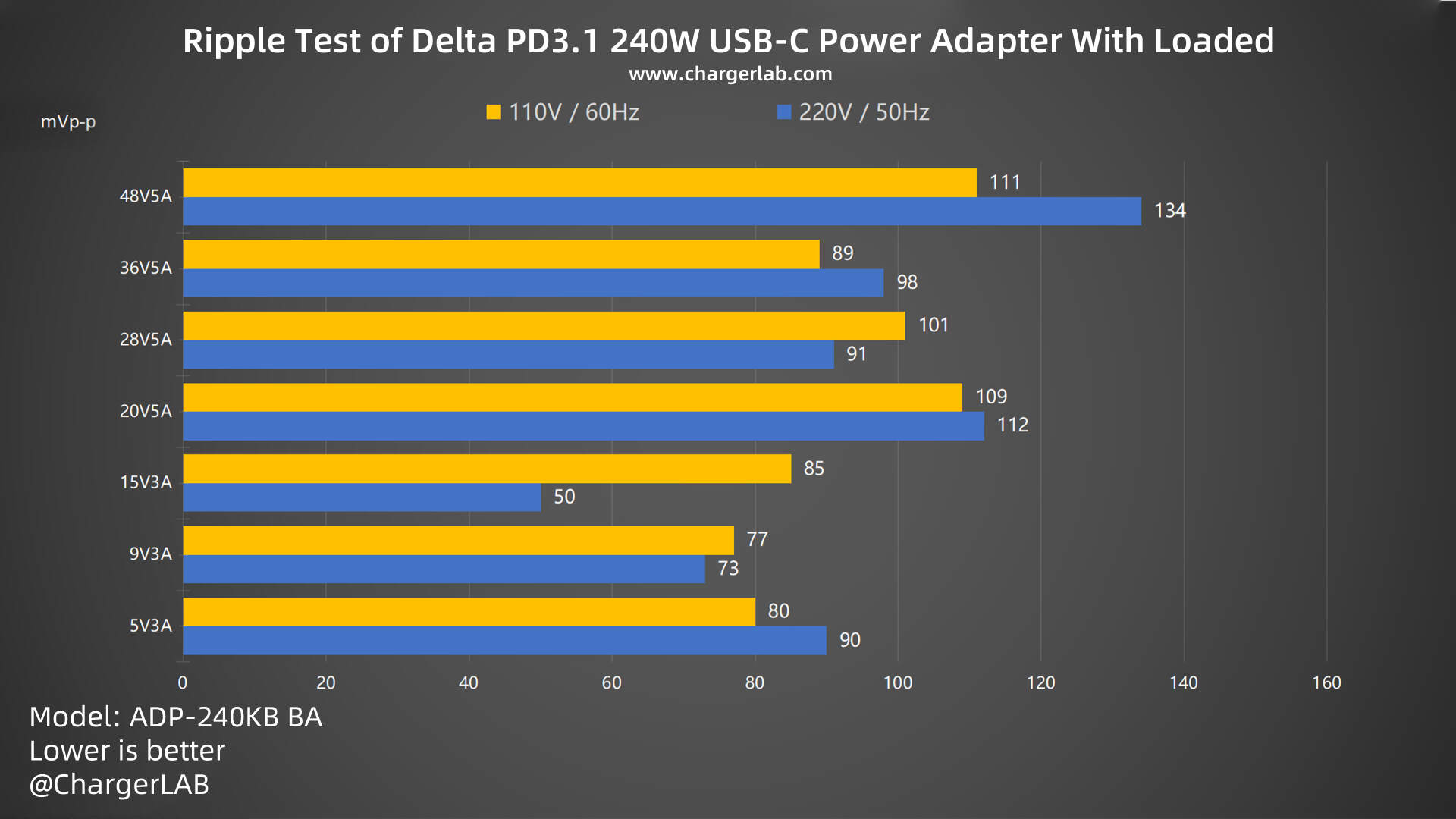
Then, move to the ripple test when loaded. When the output is 48V5A, the highest ripple is 134 mVp-p. When the output is 15V3A, the lowest ripple is 50 mVp-p.
Overall, the performance isn't good enough and the maximum is above 200mVp-p.
Temperature Test
Then, we are going to the maximum temperature test. We put the adapter into a 25°C (75℉) thermotank and ran it at full load of 48V5A 240W for one hour. And recorded the highest temperature on the front and back.
First, let’s check out the temperature performance under 220V 50Hz.
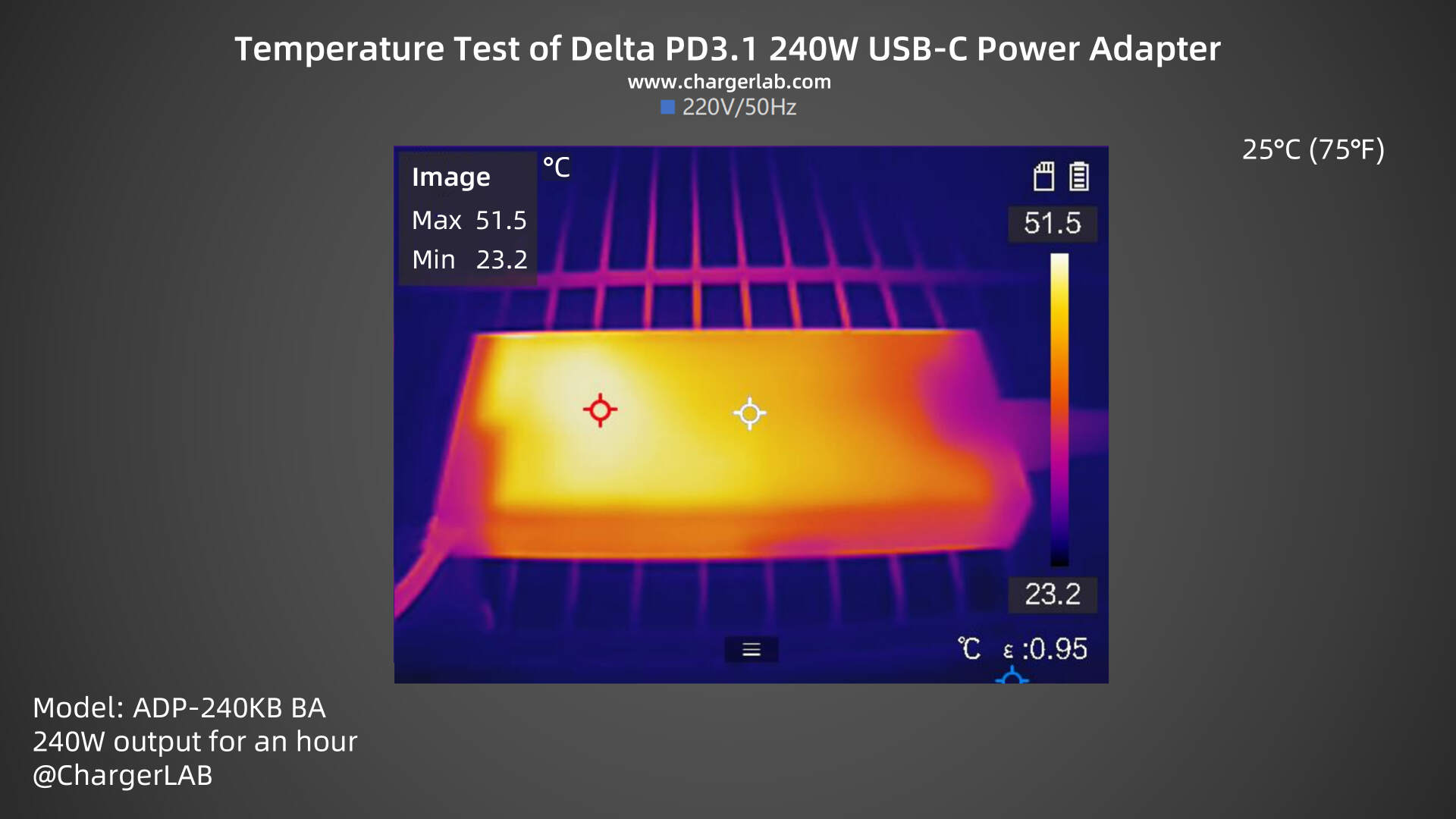
After one hour of loading, the maximum front temperature is 51.5°C (124.7 ℉).
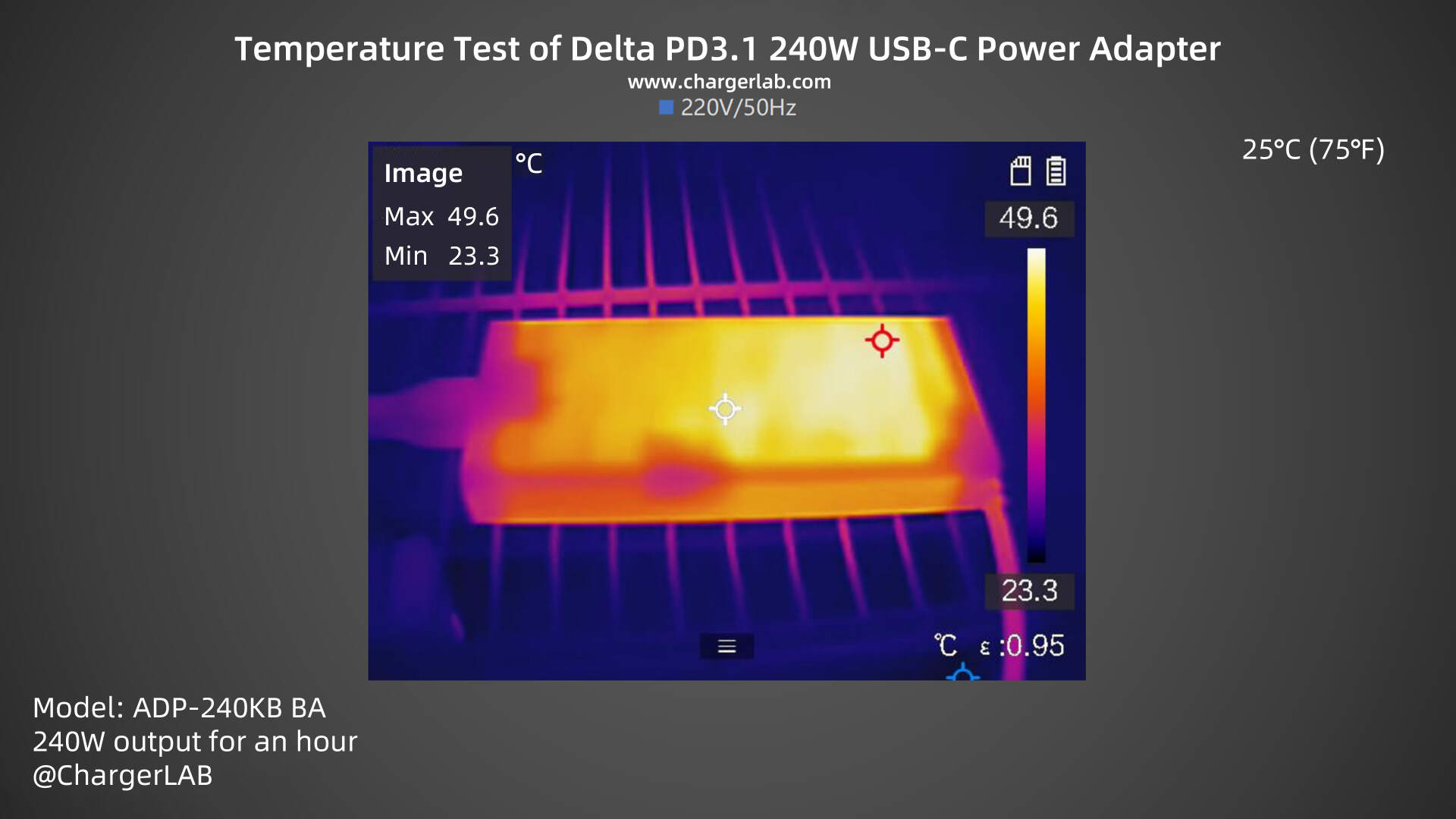
And the maximum temperature on the back is 49.6℃ (121.28 ℉).
Next check how the temperature performance is under 110V 60Hz.
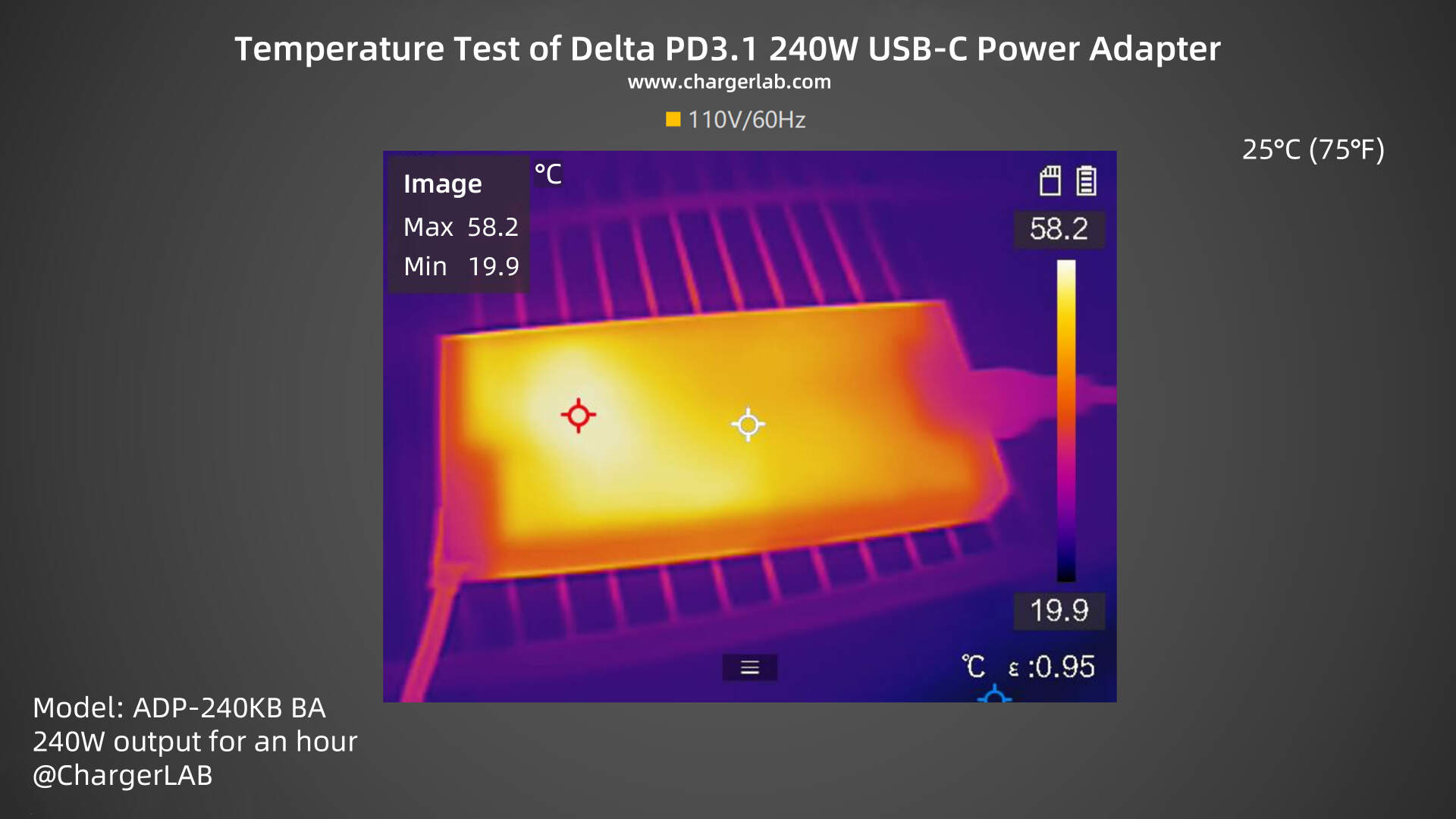
After one hour, the maximum front temperature is 58.2°C (136.76 ℉).
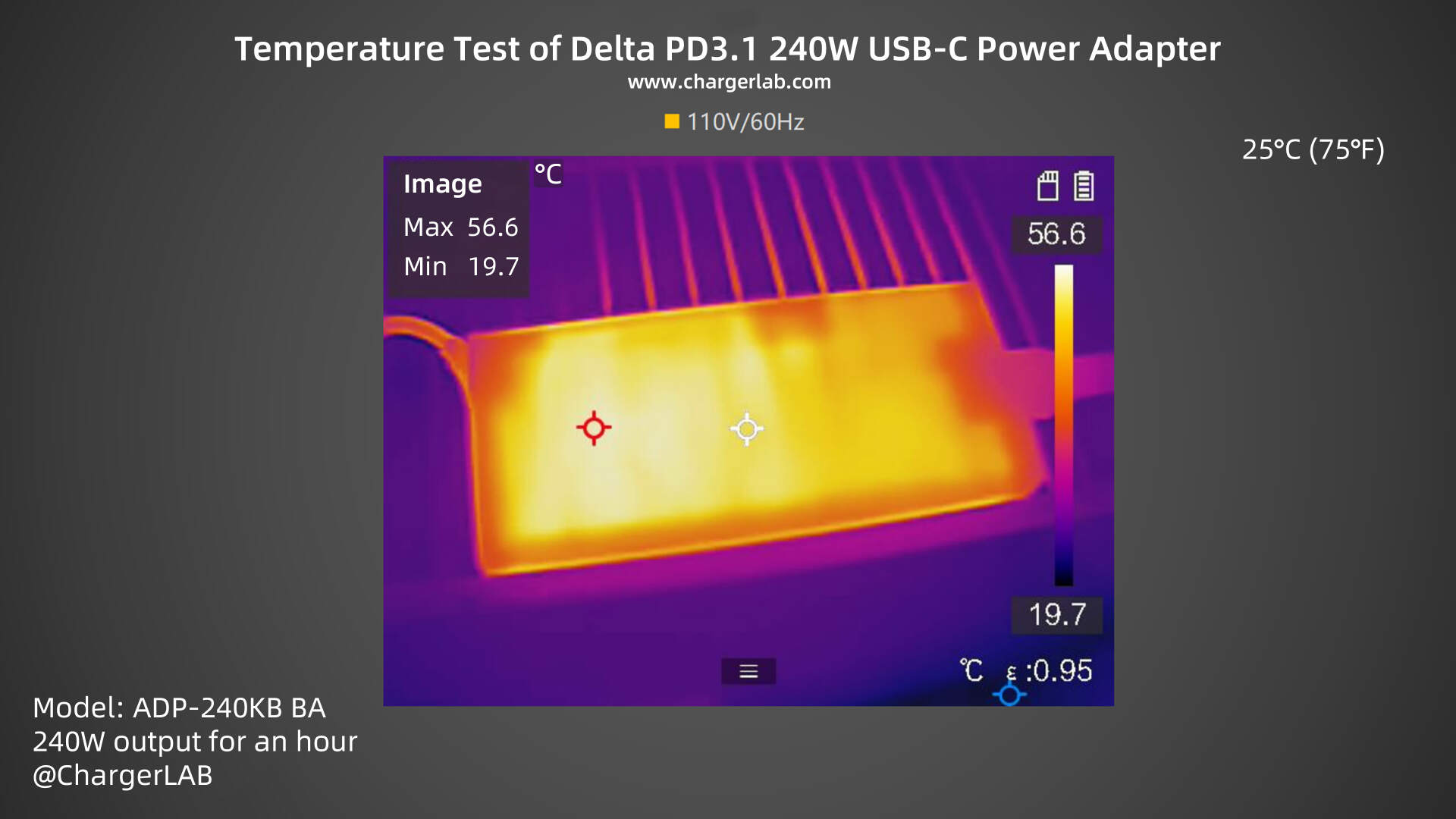
And the maximum temperature on the back is 56.6℃ (133.88 ℉).
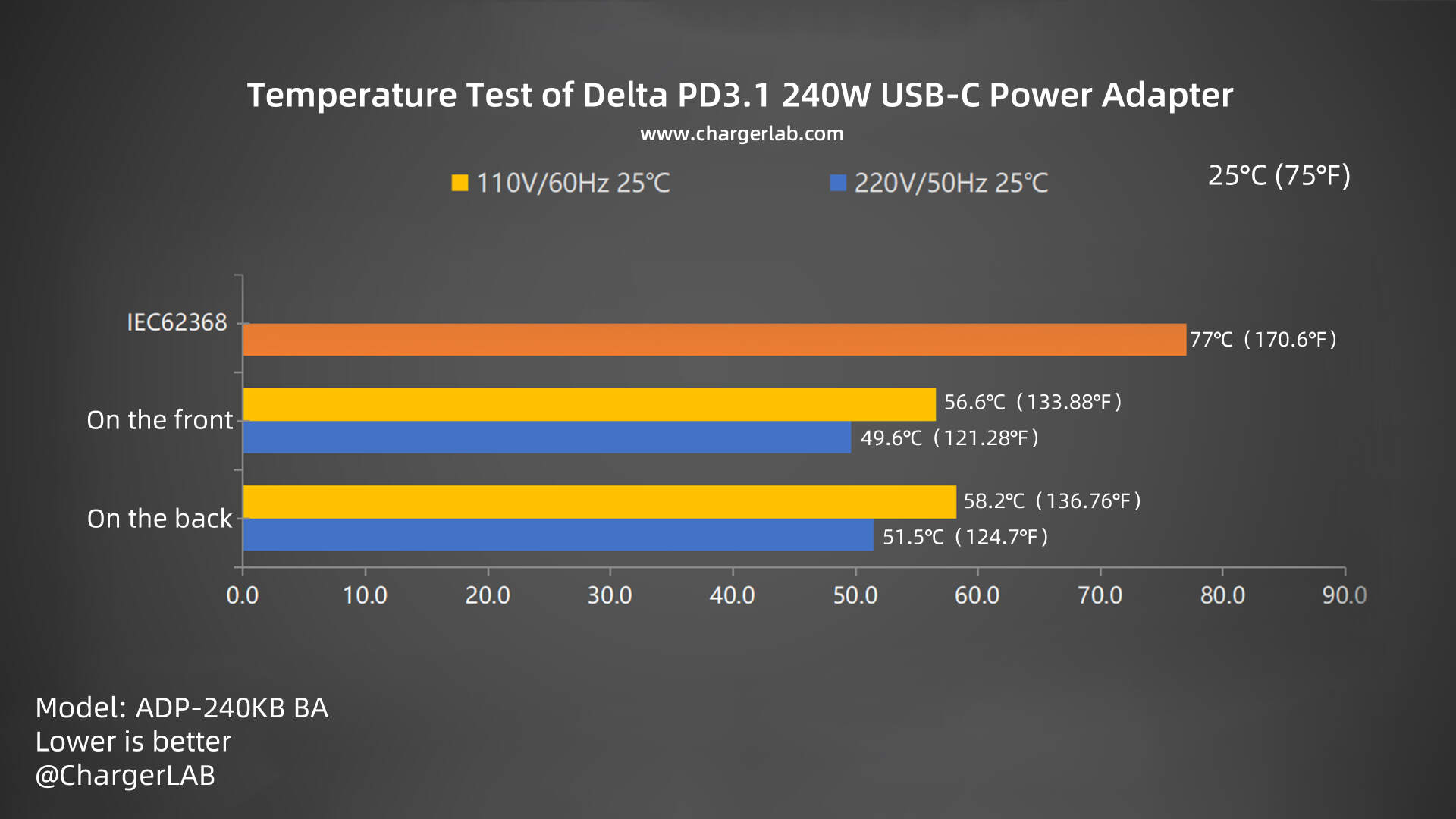
Creating a bar chart to represent the data, it is evident that this adapter reaches a maximum temperature of 58.2 ℃ when operating under 110V 60Hz. This temperature complies with the International Electrotechnical Commission (IEC) 62368 standards for electronic and electrical equipment test, which stipulates that the temperature should not exceed 77 °C.
Summary of ChargerLAB
Delta's PD3.1 240W power adapter is similar in appearance to common high-power power adapters, and the charging cable with an integrated USB-C port is compatible with most devices on the market.
It is more suitable for charging high-power devices and has lower power when charging phones. Its standby power consumption is almost negligible, reducing unnecessary energy waste. Its conversion efficiency is also excellent, especially at 48V5A, its efficiency exceeds 95%, and it performs well whether at 220V or 110V.
Its ripple when loaded does not exceed 134mVp-p, which is lower than the industry standard requirement, indicating that its output power stability is very high and suitable for long-term use. Although the temperature of the adapter increases slightly under high load, the overall temperature control performance meets international standards and is well within the safe operating range.
In general, Delta PD3.1 240W power adapter has set a new benchmark in the field of high-power power adapters. As the power demand of devices increases, this adapter will play a greater role in the charging solutions of high-performance devices in the future, and also provide the industry with more efficient and safe power options.
Related Articles:
1. Review of the Original 140W Charger of Huawei MateBook X Pro (Video)
2. PD3.1 | Review of MOVESPEED 4-in-1 GaN Charger
3. Up to 300W & PD3.1 | Review of UGREEN Nexode 5-in-1 Desktop Charger

